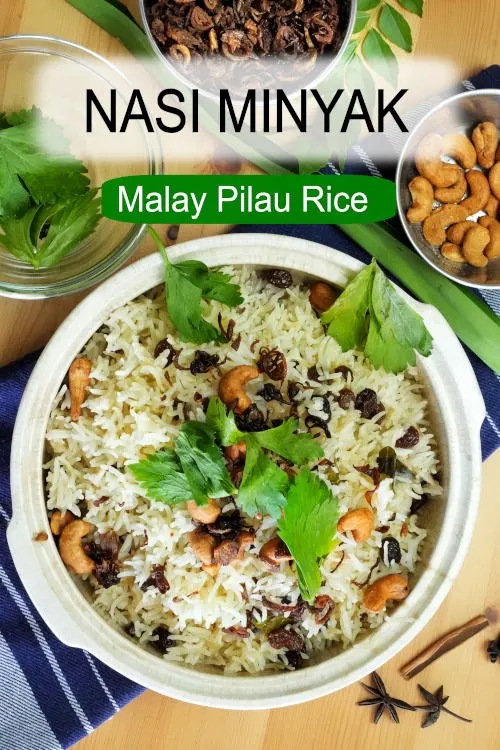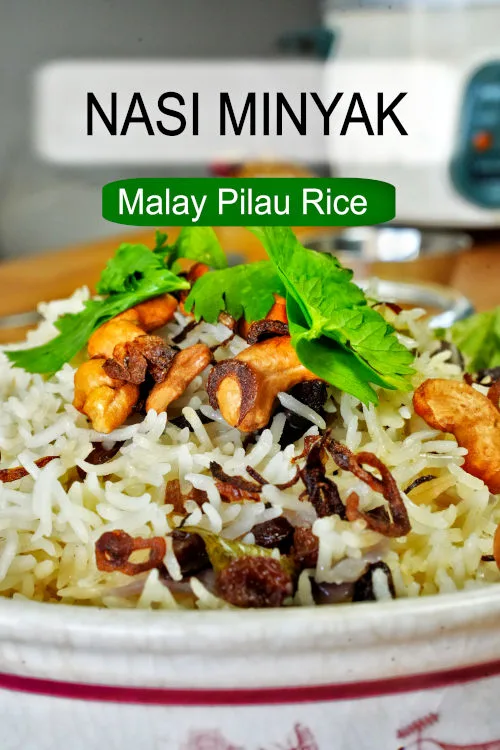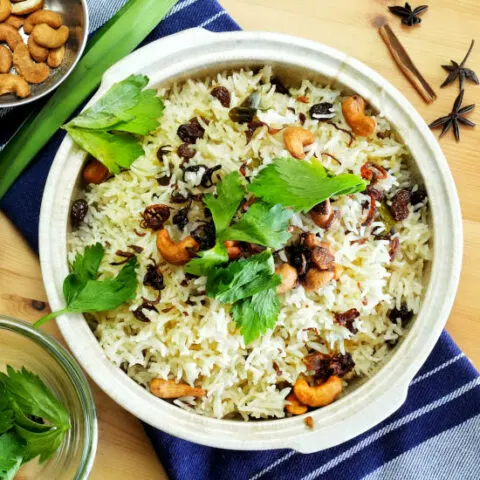Nasi minyak is a delicious Malaysian rice dish with a rich buttery flavor infused with aromatic spices. Its name translates to “oil rice” and was once exclusively served to the Malay royal family. The dish is likely named after its main ingredient, clarified butter (ghee). The ghee rice cooked with spices gives an enticing aroma.
Nowadays, this fragrant rice dish is often featured in special occasions like Malay weddings and birthday parties, served with flavorful curries or stews such as beef rendang and ayam masak merah.
This beloved dish is also popular in neighboring countries like Indonesia and Singapore, but its preparation can vary. Therefore, we will focus on preparing nasi minyak in Malaysia in this recipe.
Note: This post may contain affiliate links. Please read my privacy policy for more info. I may receive commissions for purchases made through links in this post. As an Amazon Associate, I earn from qualifying purchases.

The key points to note before preparing the nasi minyak
Let’s look at a few crucial points of this recipe before we begin.
The spices
This nasi minyak recipe is flavored with a combination of spices called Empat Sekawan, or “the four friends,” which are four common spices used in many Malay cuisines. They are cinnamon, cloves, cardamom, and star anise. These spices are the main ingredients to create Malay dishes’ unique and delicious flavors.
It’s essential to sauté them lightly to bring out the wonderful aroma of these spices. I included some curry leaves for an extra touch of authenticity, although this is optional.
The rice
The rice should be well-separated and not sticky to achieve the ideal texture. Basmathi rice is the recommended choice due to its low starch content. Soak it 30 minutes before cooking, as pre-soak rice is fluffier and lighter.
Although regular Jasmine rice can be used as an alternative, the grains may not be as well-defined as those of Basmathi rice. This is because Jasmine rice grains are shorter and contain more starch, which can make the rice soft and sticky more quickly. As a result, there is no need to soak Jasmine rice as it may make it too soft.
The amount of liquid required to cook the rice
The right amount of liquid is essential to ensure the rice turns out perfectly fluffy. I use a ratio of 1.25 cups of liquid (a mix of water and milk) for every cup of washed and drained rice. Please note that I drain the rice using a wire mesh strainer after soaking and washing.
Since regular Jasmine rice is shorter and contains more starch, I do not recommend soaking it as it tends to become soft and sticky.
This recipe can use fresh, UHT, or evaporated milk.

The step-by-step instruction for preparing nasi minyak
Preparing nasi minyak is relatively easy, especially using an electric rice cooker. First, flavor the rice with spices in a pan, then transfer it to the rice cooker and cook until it’s done.
A. Flavor the rice with the spices
- I start by thinly slicing an onion and roughly chopping garlic to make the onion-garlic paste. You can use a mortar and pestle or a spice grinder to grind these ingredients into a paste. Add some water to facilitate blending if you’re using an electric blender.
- Cut an onion into slices. Also, cut the fresh ginger into thick slices, then use the spine of a knife to bash it, which will help release its flavor more efficiently. You can easily remove the ginger after the rice has cooked by cutting it into thick pieces. You can choose to use ginger juice or finely chopped ginger instead.
- Tie two pandan leaves together in a knot since they are too long to put into the rice cooker later.
- Heat ghee (minyak sapi in Malay) and vegetable oil in a large skillet or wok. Once the oil is hot, sauté the sliced onion until it becomes soft.
- Next, add the cinnamon stick, cloves, cardamom pods, and star anise to the skillet. Once the spices turn aromatic, add the onion-garlic paste. Remember to add curry leaves and pandan leaves. Stir-fry until the spice mixture becomes fragrant.

B. Cook the rice with an electric rice cooker
- Rinse the rice thoroughly and then soak it in room temperature water for about half an hour to soften it. Basmathi rice is ideal for this recipe, although Jasmine rice will also work well. Once the soaking time is up, drain the water by pouring the rice through a wire mesh strainer.
- Next, add the rice to a skillet along with the other ingredients. The oil in the skillet will evenly coat each rice grain, ensuring they will not stick together after cooking. Next, season the mixture with salt and sugar to taste, and then add in the raisins. Finally, pour the water and milk into the skillet, stirring everything together.
- Transfer the rice mixture to an electric rice cooker and cook it until it’s done. Alternatively, you can cook the rice in a pot with the lid on over the smallest flame on the stovetop.
- After the rice cooker has completed the cooking process, let it remains in the ‘warm’ mode for another fifteen minutes before opening the lid. This step provides additional time for the rice to absorb the water and become fluffy and not soggy.
- Finally, garnish the dish with fresh coriander leaves (cilantro), fried shallots (fried onions), and cashew nuts. These toppings will give it an extra burst of flavor and texture.
Note:
- The ideal ratio of rice to liquid is 1:1.25 in volume. In other words, for every cup of wet rice used (after draining the water), you should add 1.25 cups of liquid, consisting of both water and milk. The water ratio can be up to 1:1.5 if you want softer rice.
- Do not soak the rice to prevent it from becoming too soft if you use normal rice.
- It’s worth noting that some recipes include artificial coloring to enhance the rice’s appearance. However, I do not use artificial coloring in this recipe unless I prepare it for a special occasion.
- Nasi minyak is commonly presented with acar (pickled vegetables), serunding as side dishes., and ayam masak merah (chicken in a hot tomato sauce) as the main.

Nasi Minyak (Malay Pilau Rice)
Traditional Malaysian flavor Nasi Minyak recipe. Simple to follow guide with comprehensive instructions.
Ingredients
Ingredeints A (blend)
- 1 medium size onion
- 3 clove garlic
Ingredeints B (saute)
- 1 onion, small cubes
- 1 inch ginger, into pieces
- 2 pandan leaves
- 1 stalk curry leaves
- 2 tbsp ghee
- 2 tbsp cooking oil
- 1 cinnamon stick
- 4 cardamom pods
- 4 cloves
- 1 star anise
Ingredients C (Rice)
- 2 cups basmathi rice
- 0.75 cup milk, top up with water until total is 2.5 cups
- 1 tsp sugar
- 1 tsp salt
- 1/4 cup raisins
Ingredients D (garnish)
- Fried shallots
- Cashews
- Cilantro leaves
Instructions
Flavor the rice with the spices
- Thinly slice an onion, roughly chop garlic, and grind these ingredients into a paste. Add some water to facilitate blending if you're using an electric blender.
- Cut an onion into slices. Cut the fresh ginger into thick slices, then use the spine of a knife to bash it, which will help release its flavor more efficiently.
- Tie two pandan leaves together in a knot.
- Heat ghee and vegetable oil in a large skillet. Sauté the sliced onion until it becomes soft.
- Add the cinnamon stick, cloves, cardamom pods, star anise, onion-garlic paste, curry leaves, and pandan leaves. Stir-fry until the spice mixture becomes fragrant.
Cook the rice with an electric rice cooker.
- Rinse the rice thoroughly and then soak it in room temperature water for about half an hour to soften it.
- Drain the water by pouring the rice through a wire mesh strainer.
- Add the rice to a skillet and mix with the other ingredients.
- Season the mixture with salt and sugar to taste, and then add in the raisins.
- Pour the water and milk into the skillet, stirring everything together.
- Transfer the rice mixture to an electric rice cooker and cook it until it's done.
- Let it remains in the ‘warm’ mode for another fifteen minutes after it is done before opening the lid.
- Finally, garnish the dish with fresh coriander leaves, fried shallots (fried onions), and cashew nuts.
Nutrition Information:
Yield: 3 Serving Size: 1Amount Per Serving: Calories: 403Total Fat: 20gSaturated Fat: 7gTrans Fat: 0gUnsaturated Fat: 12gCholesterol: 27mgSodium: 837mgCarbohydrates: 51gFiber: 3gSugar: 14gProtein: 6g
This data was provided and calculated by Nutritionix on 12/3/2023

Mark
Friday 1st of September 2023
Sorry but the Ingredients and the process do not match. Need to rewrite this recipe.
KP Kwan
Friday 1st of September 2023
Thank you Mark. I have corrected the mistake.
KP Kwan
Monday 13th of March 2023
Hi, this is KP Kwan. I am happy to see you in this comment area, as you have read through my recipe. I am glad to reply to any questions and comments as soon as possible.